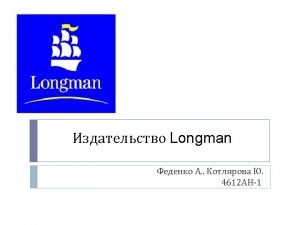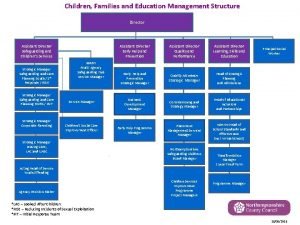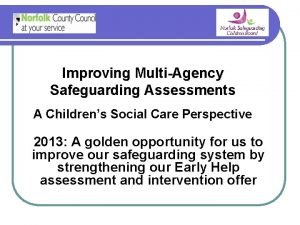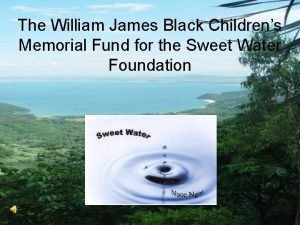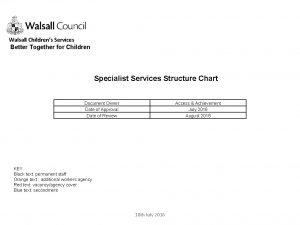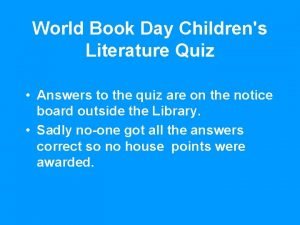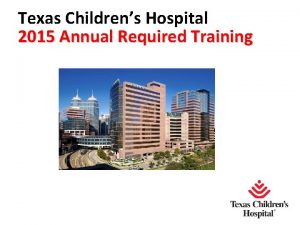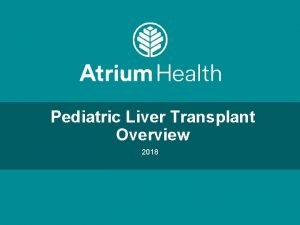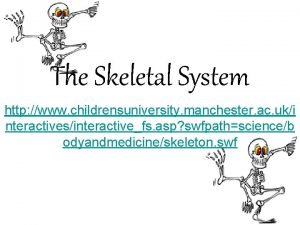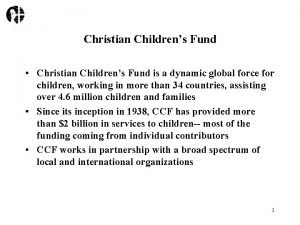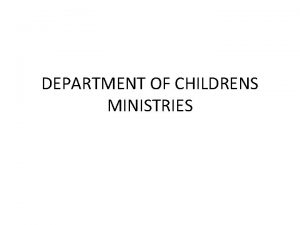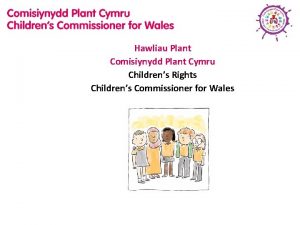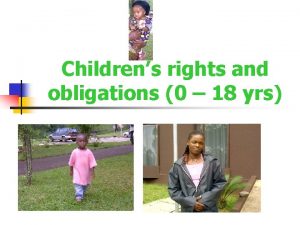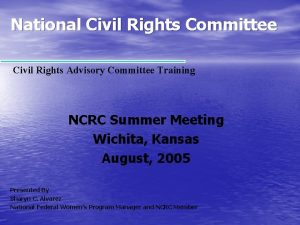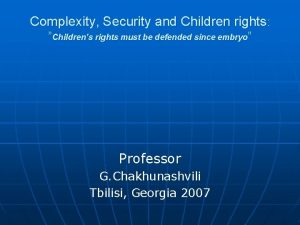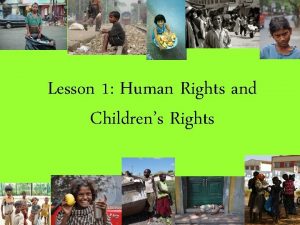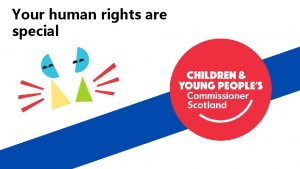Committee on the Rights of the Childrens Rights












- Slides: 12

Committee on the Rights of the Children’s Rights and the Environment 2016 General Day of Discussion Working group 1: Children’s exposure to environmental toxicants Dr. Lilian Corra

WHO: Preventing disease through healthy environments A global assessment of the burden of disease from environmental risks 2016 In children under 5 years, up to 26% (16 -38%) of all death could be prevented if environmental risks were removed. In developing countries this number may be significantly higher.

Children are not little adults v Physiology of development and immature detoxification v Longer life expectancy: more time to be exposed and to develop diseases v Different and unique exposures: o Unique exposure pathways: preconception, in utero, breastfeeding o Exploratory behaviors leading to exposures: hand/object/mouth o Stature and living zones, micro-environments: lower to the ground, higher surface area to volume ratio that adults o Children do not understand danger: pre-ambulatory, adolescence “high risk” behaviors 3

Vulnerability: A clean environment for the weakest Children are the most vulnerable v Are exposed SINCE CONCEPTION (protection of young people of reproductive age) v Children need healthy environments in which to grow, develop, play and learn v Effects: von neurodevelopment (behavior, intellectual functions and IQ) v fertility (reproduction) Their loss and disease causes deep emotional damage. Politically powerless: children have not political voice! 4

Inaction to protect children from environmental risks is inacceptable: environmental risks are avoidable cause of disease and death Toxic exposure during all the periods of development has a deep impact on health and quality f life of children, adults, productivity and sustainable development. Includes: • reproductive age, • pregnant mothers, • newborns (up to 28 days), • infants (28 days to 1 year). • young children (1 -4), • older children (5 -12) and • adolescents (12 -18).

ENVIRONMENTAL THREATS OF CONCERN ARE RELATED TO PEDIATRIC ILLNESSES ARE RELATED TO EMERGING ISSUES v Global climate change v Ozone depletion v Some radiations CHEMICALS OF CONCERN v Heavy metals: Lead and mercury v Pesticides v POPs v Endocrine disruptors v Arsenic v Mycotoxins v Chemicals from pharmaceuticals origin in the environment v Others New or "re-emerging" potential threats to children's health and development WHO 25/09/2020 6

Estimated cost of morbidity and mortality Lead in children in the US - 2011 Current estimates from WHO are that about 12 million children in developing countries may suffer permanent brain damage due to lead poisoning. Combined environmentally attributable costs of lead exposure, methylmercury exposure, developmental disabilities, asthma and cancer to be $70. 9 billion in 2008. Bartlett ES 1, Trasande L. Eur J Public Health. 2014 Feb; 24(1): 21 -6. doi: 10. 1093/eurpub/ckt 063. Epub 2013 Jun 6. There is an important sub-registration, differences in the indicators, definitions, and age categories implemented by the different agencies that collect and report childhood health and exposure. 25/09/2020 7

Case studies Hospital Garraham Children’s Hospital Buenos Aires - Argentina Dra. Marisa Gaioli Hospital Garraham is the most important pediatric hospital in Argentina and Latin America and one of the 10 best in the world.

Case study 1: arsenic in drinking water and hypertension • A 12 -year-old girl presented migraines and hypertension, medicated since a year ago. • Her mother mentioned that the girl’s aunt and other neighbors have health problems due to arsenic present in the drinking water in the area. • Testing found high arsenic levels in the patient’s urine. • The girl was advised to drink bottled water and stop using well water. • Hypertension and arsenic levels dropped after three months and anti-hypertensive medication was withdrawn, blood tension remaining low.

Case study 2: mercury exposure and neurologic condition • A 14 -year-old boy experiencing back pain, weakness, paralysis, hand tremors and weight loss, was diagnosed with Guillain-Barre syndrome. • Specific treatment was not alleviating the symptoms. • Testing revealed very high mercury levels for the boy, mother and sisters. • The boy had been involved informally in breaking fluorescent tubes to reduce waste volume, which exposed him to mercury. • His family was exposed by washing their clothes together, which transferred contaminants to family members. • Specific treatment was administrated, the symptoms reversed and the patient cure.

Health is more than absence of illness. Adults must ensure children develops their full capacity, enjoy quality of life and clean environments as well as protect them from environmental threats. Now and for generations to come!

ISDE 25 th Anniversary 1990 -2015 Voluntary work
 Longman children's picture dictionary
Longman children's picture dictionary Childrens services
Childrens services Colorado childrens book award
Colorado childrens book award Kirklees safeguarding childrens board
Kirklees safeguarding childrens board Black childrens memorial
Black childrens memorial Walsall childrens services
Walsall childrens services World book day quiz
World book day quiz Texas children's hospital moli
Texas children's hospital moli Toddler fever 102
Toddler fever 102 Levine childrens
Levine childrens Manchester childrens university
Manchester childrens university The christian childrens fund
The christian childrens fund History of childrens literature
History of childrens literature
